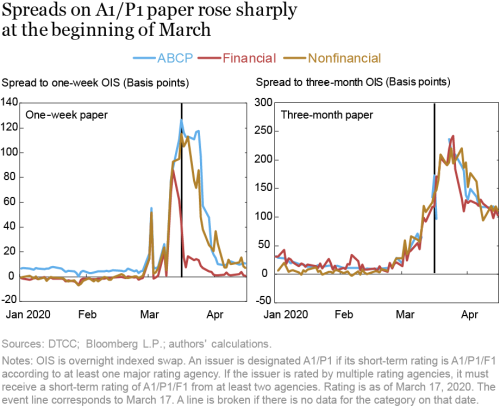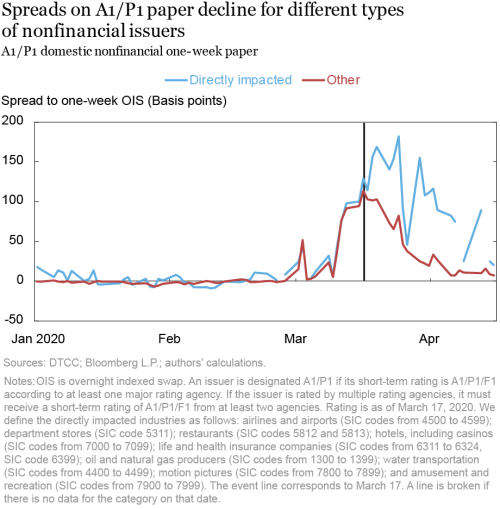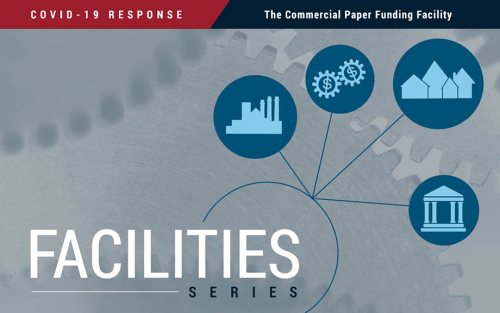This post is part of an ongoing series on the credit and liquidity facilities established by the Federal Reserve to support households and businesses during the COVID-19 outbreak.
In mid-March, the Federal Reserve announced a slew of credit and liquidity facilities aimed at supporting credit provision to U.S. households and businesses. Among the initiatives is the Commercial Paper Funding Facility
(CPFF) which aims to support market functioning and provide a liquidity backstop for the commercial paper market. The domestic commercial paper market provides a venue for short-term financing for companies which employ more than 6 million Americans. Securities in the commercial paper market represent a key asset class for money market mutual funds. This post documents the dislocations in the commercial paper market that motivated the creation of this facility, and tracks the subsequent improvement in market conditions.
What is commercial paper?
Commercial paper is one of the oldest forms of finance, dating back to colonial times when bills of exchange allowed the safe and convenient transfer of funds between the time of purchase and payment for goods. Today, the commercial paper market provides short-term funding to a range of financial and nonfinancial companies. Although commercial paper is a short-term instrument, it is typically issued as part of an ongoing program. It is often used to finance cash needs of high-quality firms that change throughout the year (low-quality firms are typically not able to fund through this market). Investors in the commercial paper market include prime money funds and other buyers who seek assets with short maturities.
Nonfinancial companies use commercial paper similar to a revolving credit line to fund payroll, accounts payable, and inventory purchases, among other activities. Banks and other financial intermediaries use commercial paper to fund loans and other assets. With around $734 billion of commercial paper outstanding as of the end of 2019, commercial paper represents a substantial source of short-term funding for domestic nonfinancial and financial issuers alike.
Background to the CPFF
In March, financial markets began to experience disruptions related to the outbreak of COVID-19, and the commercial paper market was no exception. Anecdotally, investors in the market were unwilling to extend credit to issuers except at very short maturities of less than five days. As the chart below shows, this reduced availability of credit coincided with yield-spread increases even for the highest-rated issuers—those with short-term credit ratings of A1 (Moody’s) or P1 (S&P)—across the maturity spectrum. This market dislocation negatively impacted companies that needed to refinance their maturing commercial paper at a time when they urgently needed liquidity to fund operational disruptions.

What is the CPFF?
In light of these events, on March 17, the Federal Reserve announced the CPFF. The CPFF is a temporary liquidity facility authorized under Section 13(3) of the Federal Reserve Act. It is funded with loans from the Federal Reserve Bank of New York and includes a $10 billion equity investment from the U.S. Treasury’s Exchange Stabilization Fund. The facility was announced on March 17 and began its operations on April 14. The CPFF uses a structure that is similar to the CPFF facility introduced in the wake of the collapse of Lehman Brothers in fall of 2008. The previous facility successfully ameliorated strains in the commercial paper market during the financial crisis (see this post for further information). The CPFF both supports commercial paper liquidity in the short run, by providing highly rated issuers with an alternative outlet for their current commercial paper issuance, and in the longer run, as both issuers and investors can be more confident about participating in the market knowing that issuers will be able to roll over outstanding commercial paper. By setting the rate at which it will purchase commercial paper at a premium to “normal” market pricing, the CPFF stands as a lender of last resort for the A1/P1 commercial paper market, with take-up expected to dissipate as market conditions normalize.
The current incarnation of the facility is designed to work in concert with the Money Market Mutual Fund Liquidity Facility (MMLF). By allowing issuers to buy back outstanding commercial paper and re-issue using the CPFF, the CPFF reduces the strain placed on money market funds invested in commercial paper. At the same time, by providing liquidity support to money market funds, the MMLF mitigates fire-sale dynamics, supporting commercial paper liquidity. For more details on the MMLF, see this post in our facilities series.
What has been the impact of the facility?
The chart above shows that, for the shortest maturity issuances, the spreads to one-week OIS (overnight indexed swap) on one-week A1/P1 paper started declining immediately once the facility was announced on March 17, with the spread on nonfinancial commercial paper declining from 112 basis points (bps) on March 17 to 5 bps on April 16, and the spread on financial commercial paper declining from 38 bps on March 17 to 0 bps on April 16. The response of spreads on longer maturity commercial paper was more sluggish, with the spreads to three-month OIS on three-month A1/P1 nonfinancial commercial paper only starting to decline on March 25 from 220 bps to 111 bps on April 16. Similarly, the spreads to three-month OIS on three-month A1/P1 financial commercial paper started to decline on March 26 from 242 bps to 103 bps on April 16.
While the facility only accepts commercial paper from issuers rated A1/P1 as of the facility announcement date, by stabilizing the A1/P1 market the facility has had a positive impact on market functioning and liquidity for lower-rated issuers as well, as shown in the next chart. As with the A1/P1 market, the shortest maturity spreads reacted immediately, with the spread on nonfinancial commercial paper declining from 311 bps on March 17 to 87 bps on April 16, and the spread on financial commercial paper declining from 123 bps on March 17 to 5 bps on April 16. The reaction of longer maturity spreads has been more sluggish, with a modest 50 bps decline in the spread on nonfinancial three-month paper over the period from March 17 to April 16.

Inspecting the A1/P1 nonfinancial issuers in greater detail, we can examine whether market pricing for issuers in industries more likely to be directly affected by the COVID epidemic—such as airlines, department stores, restaurants, and hotels—has evolved in the same way as for issuers less likely to be directly affected. The next chart shows that, although spreads on one-week paper have declined for both sets of issuers since the facility announcement, the decline in spreads for more directly affected issuers has been more modest. The facility thus achieves its twin goals of supporting overall commercial paper market liquidity while allowing market participants to differentially price issuers with different risk profiles.

Supporting Economic Stability
Unlike CPFF usage during the 2007-09 financial crisis, current usage of the CPFF has been relatively limited. Nonetheless, the return to normal market prices documented above means that the facility is working—providing a backstop but at terms that encourage issuers to seek public market financing. While the initial disruptions to the commercial paper market appear to have subsided, the facility stands ready to help weather any additional disturbances that may emerge until the COVID-related disruptions to the economy are resolved.

Nina Boyarchenko is an officer in the Federal Reserve Bank of New York’s Research and Statistics Group.

Richard Crump is a vice president in the Federal Reserve Bank of New York’s Research and Statistics Group.

Anna Kovner is a vice president and policy leader for financial stability in the Bank’s Research and Statistics Group.
Also in the Liberty Street Economics Facilities Series
Helping State and Local Governments Stay Liquid, April 10
The Money Market Mutual Fund Liquidity Facility, May 8
The Primary Dealer Credit Facility, May 19
The Paycheck Protection Program Liquidity Facility (PPPLF), May 20
The Primary and Secondary Market Corporate Credit Facilities, May 26
Securing Secured Finance: The Term Asset-Backed Securities Loan Facility, August 7
Related Content on newyorkfed.org:
Video: The Commercial Paper Funding Facility, Explained
How to cite this post:
Nina Boyarchenko, Richard Crump, and Anna Kovner, “The Commercial Paper Funding Facility,” Federal Reserve Bank of New York Liberty Street Economics, May 15, 2020, https://libertystreeteconomics.newyorkfed.org/2020/05/the-commercial-paper-funding-facility.html.
Disclaimer
The views expressed in this post are those of the author and do not necessarily reflect the position of the Federal Reserve Bank of New York or the Federal Reserve System. Any errors or omissions are the responsibility of the author.











 RSS Feed
RSS Feed Follow Liberty Street Economics
Follow Liberty Street Economics